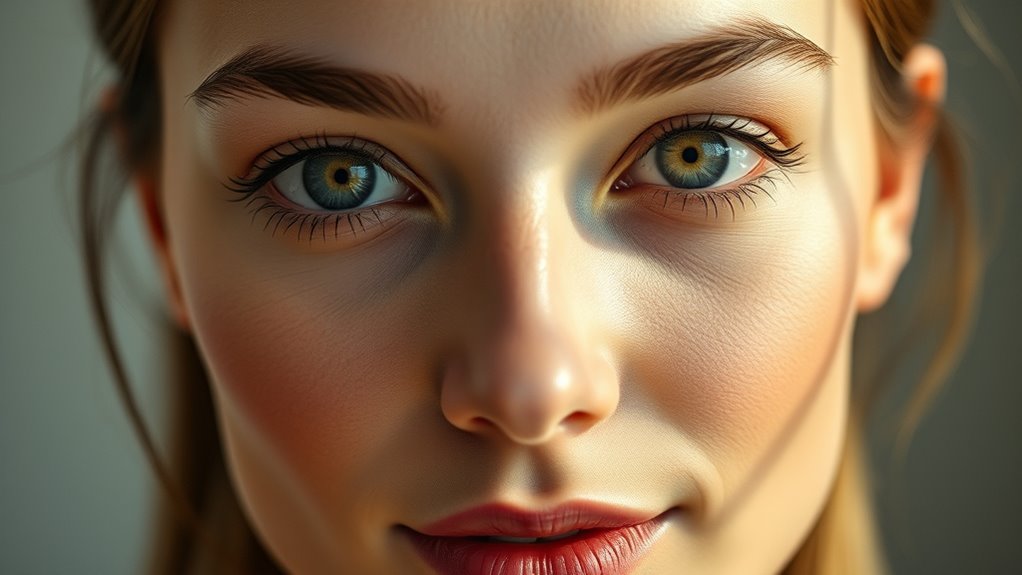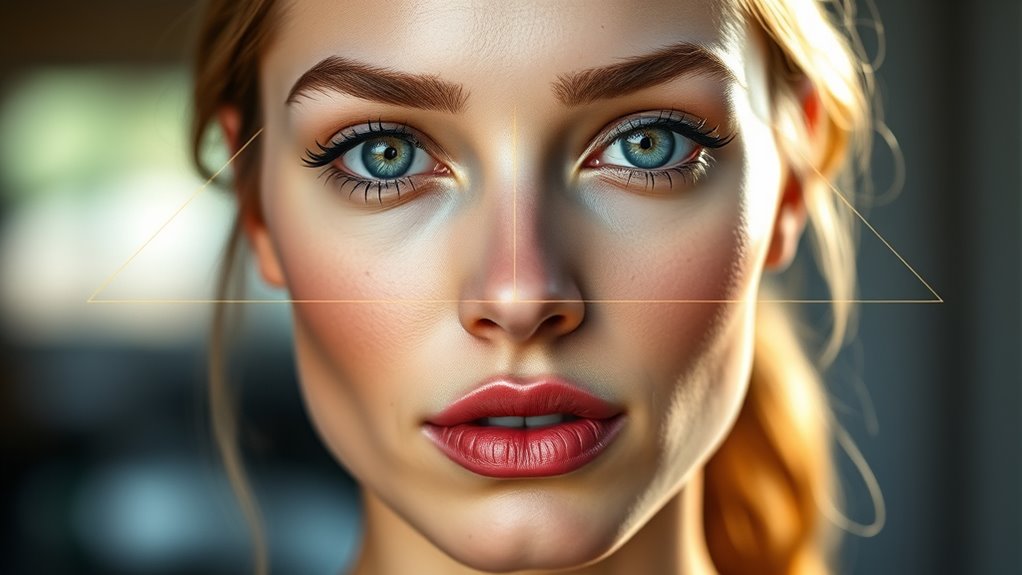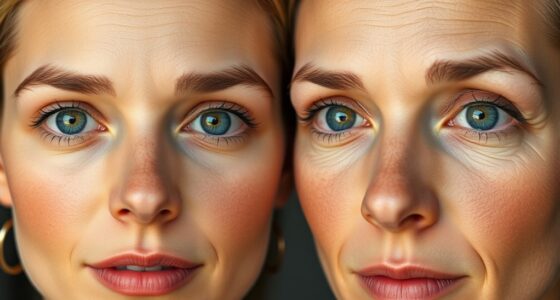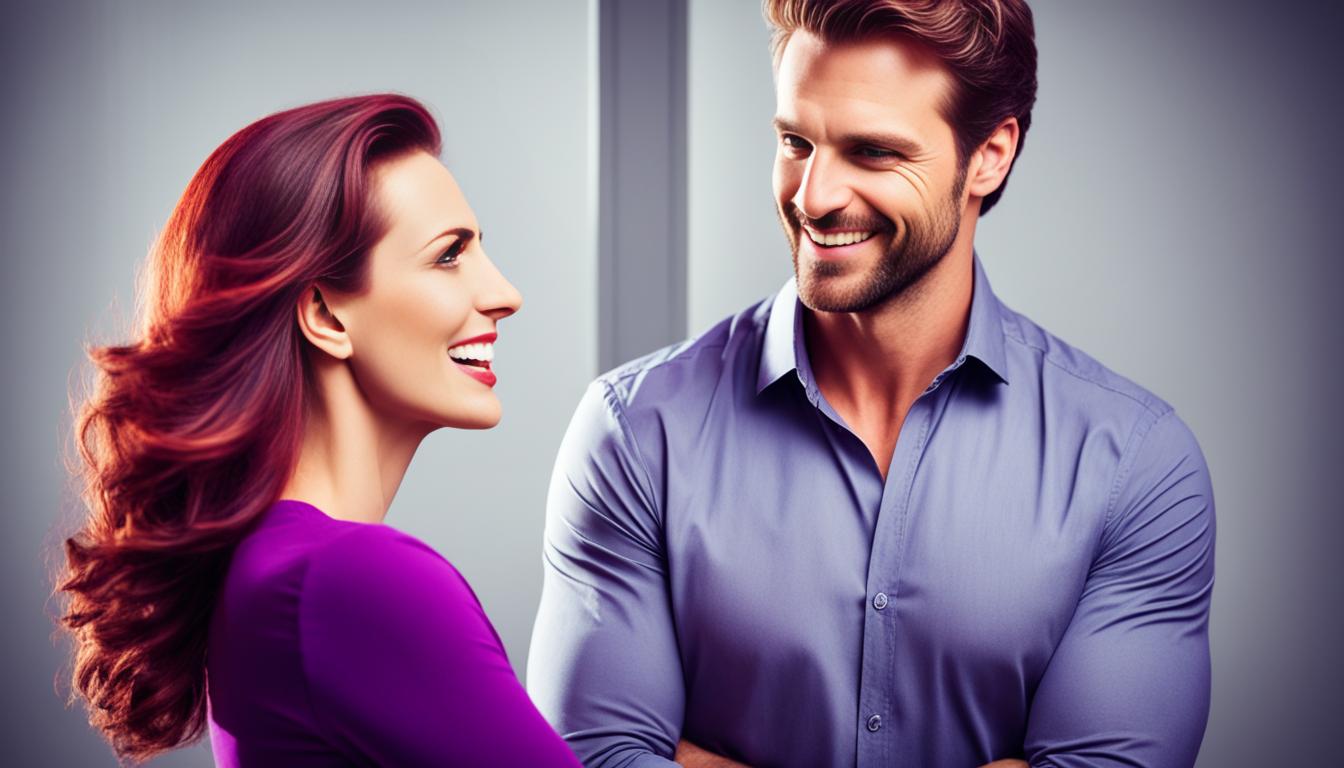The idea that the golden ratio determines facial beauty is more fiction than fact. While some believe this mathematical proportion—about 1.618—makes features more attractive, beauty is much more complex. Cultural standards, personal preferences, and biological diversity all play a role. No single ratio can define attractiveness universally. If you want to understand how beauty varies across cultures and the role of proportions in cosmetic practices, there’s more to discover below.
Key Takeaways
- The golden ratio appears in some facial proportions but is not a universal standard of beauty.
- Cultural differences heavily influence what is considered attractive, often overshadowing mathematical ratios.
- Cosmetic practices may reference the golden ratio, but results prioritize harmony, individuality, and cultural ideals.
- Human beauty is complex, involving personality, confidence, and cultural context beyond just facial proportions.
- Relying solely on the golden ratio oversimplifies beauty, which is ultimately a multifaceted and subjective concept.

Have you ever wondered what makes some faces universally appealing? It’s a question that has intrigued many for centuries, often leading to the idea that the golden ratio holds the secret to perfect beauty. The golden ratio, approximately 1.618, is a mathematical proportion that appears frequently in nature and art. Some believe that when facial features align with this ratio, the face is inherently more attractive. This idea has influenced cosmetic surgery, with practitioners sometimes aiming to enhance features to match these proportions, hoping to create a universally appealing look. However, it’s essential to recognize that beauty isn’t solely defined by numbers. Cultural perceptions play a significant role in shaping what different societies find attractive. In some cultures, high cheekbones or specific eye shapes are prized, while others may value softer features or different facial structures altogether. The golden ratio can serve as a guideline, but it doesn’t dictate beauty universally.
When you look at faces across various cultures, you’ll notice a wide range of what’s considered attractive. This diversity underscores that beauty standards are deeply rooted in cultural perceptions, which evolve over time and are influenced by historical, social, and media-driven factors. Cosmetic surgery, for example, often reflects these cultural ideals rather than an objective standard of beauty. People seek procedures to align their features with what’s culturally revered, whether that’s a certain nose shape, jawline, or eye size. While the golden ratio may be referenced in some cosmetic practices, it’s rarely the sole criterion. Instead, surgeons take into account individual facial harmony, personal preferences, and cultural context to achieve results that feel authentic and expressive of the person’s identity.
Additionally, understanding that the psychological impact of beauty standards can influence individual self-esteem highlights the importance of embracing personal uniqueness over strict adherence to numerical ideals. It’s worth noting that the obsession with mathematical perfection can sometimes overlook the importance of uniqueness and personality. Beauty isn’t about fitting into a perfect mold; it’s about feeling confident and comfortable in your own skin. The golden ratio might be an interesting mathematical concept, but it doesn’t capture the full spectrum of human beauty. When considering cosmetic surgery or evaluating facial attractiveness, remember that cultural perceptions and personal identity are just as vital—if not more so—than any numerical standard. Ultimately, what makes a face appealing is a complex blend of proportion, personality, and cultural influences that go far beyond a single ratio.
Frequently Asked Questions
Does the Golden Ratio Vary Across Different Ethnicities?
You might wonder if the golden ratio varies across ethnicities. In reality, ethnic variations influence beauty standards, making perfect adherence to the ratio less universal. Different cultures emphasize unique facial features, so what’s considered beautiful can differ widely. The golden ratio offers a guideline, but it’s not a strict rule across all ethnicities. Embracing diverse features aligns with broader beauty standards that celebrate individuality and cultural differences.
Can the Golden Ratio Be Applied to Non-Human Faces?
Think of applying the golden ratio to animal faces like trying to find pattern in a complex quilt. You can use machine learning to analyze animal faces, revealing whether they follow the same aesthetic principles as humans. While some features may align with the golden ratio, others don’t, showing that beauty isn’t always governed by mathematical perfection. This approach helps us understand animal facial structures beyond human standards.
How Does Facial Symmetry Relate to the Golden Ratio?
Facial symmetry reflects how balanced your facial proportions are, which many believe enhances attractiveness. Through symmetry analysis, you can see if features align evenly on both sides, often correlating with the golden ratio. When your facial proportions follow this ratio, your face tends to appear more harmonious. So, understanding and improving symmetry can boost your perception of beauty, emphasizing how balance plays a key role in attractiveness.
Are There Cultural Differences in Perceptions of Facial Beauty?
You might notice that cultural preferences and societal standards greatly influence perceptions of facial beauty. Different cultures value distinct features, such as eye shape, skin tone, or facial structure, shaping what is considered attractive. These diverse preferences show that beauty isn’t universal; instead, it varies widely based on cultural norms and societal expectations. Embracing these differences helps you understand that beauty standards are fluid and culturally influenced.
Is the Golden Ratio Relevant for Digital or Virtual Avatar Design?
You might think the golden ratio isn’t relevant for digital aesthetics and avatar proportions, but it actually guides how appealing designs feel to users. By applying these proportions, you can create more balanced, harmonious virtual characters that resonate universally. Using the golden ratio in digital or virtual avatar design helps guarantee your creations look natural and engaging, enhancing user experience and making your avatars stand out in a crowded digital landscape.
Conclusion
So, next time you wonder if beauty really follows the golden ratio, remember it’s not about perfect proportions but about perception, confidence, and individuality. Beauty isn’t a formula to be cracked or a number to match; it’s about feeling good, embracing your uniqueness, and celebrating diversity. Whether or not the golden ratio holds true, what truly matters is how you see yourself and how others see your confidence shining through. After all, beauty is beautifully subjective.










